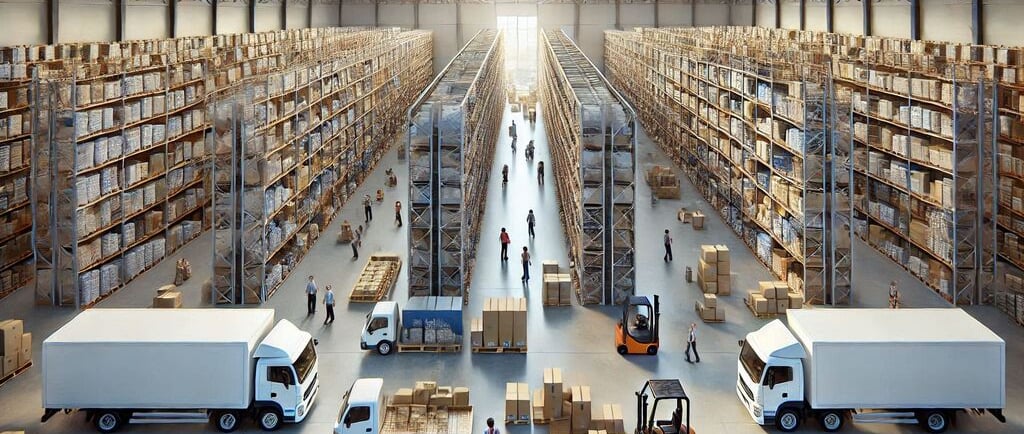Let us collaborate to foster global growth and development together.
Consolidation and Warehousing Services
Discover how consolidation and warehousing services can reduce costs, improve supply chain efficiency, and streamline logistics for businesses of all sizes.
5/23/20073 min read


Meta Description:
Discover how consolidation and warehousing services can reduce costs, improve supply chain efficiency, and streamline logistics for businesses of all sizes.
Consolidation and Warehousing Services: Streamlining Your Supply Chain
In the fast-evolving world of logistics and supply chain management, businesses are constantly searching for ways to reduce costs, optimize inventory, and enhance delivery times. This is where consolidation and warehousing services come into play. These services not only streamline logistics but also offer a scalable solution for businesses to meet increasing customer demands. Let’s dive into how these services work and why they’re vital for businesses in 2024.
What Are Consolidation and Warehousing Services?
Consolidation Services
Consolidation involves combining multiple smaller shipments into one larger load. By grouping products heading to the same destination, businesses can save on shipping costs while improving operational efficiency. This approach is particularly beneficial for small-to-medium-sized enterprises (SMEs) that don’t generate enough volume to ship full truckloads regularly.
For example, imagine a retailer sourcing goods from multiple suppliers. Instead of shipping each supplier’s goods separately, consolidation enables those products to be combined into a single shipment for delivery to the retailer’s distribution center.
Warehousing Services
Warehousing involves storing goods in a centralized facility to manage inventory effectively. Modern warehouses don’t just serve as storage facilities—they are integral parts of supply chain operations, offering value-added services such as inventory management, order processing, and packaging.
By leveraging warehousing services, businesses can:
Manage fluctuating inventory demands.
Position products closer to customers for faster delivery.
Utilize advanced tracking and inventory systems.
Benefits of Consolidation and Warehousing Services
1. Cost Savings
The primary advantage of combining these services is cost reduction. Consolidation minimizes transportation costs by reducing the number of shipments, while warehousing allows businesses to store inventory closer to their end customers, reducing last-mile delivery expenses.
2. Improved Inventory Management
Warehousing solutions often include advanced inventory management systems (IMS) that track stock levels in real time. This helps businesses avoid overstocking or understocking, ensuring a balanced supply. Consolidation complements this by preventing shipment delays, ensuring products are available when needed.
3. Faster Delivery Times
Consolidated shipments and strategically located warehouses lead to reduced transit times. A regional warehouse network can decrease shipping distances, ensuring that orders reach customers faster—a critical factor in today’s e-commerce-driven market.
Key Features to Look for in Consolidation and Warehousing Providers
When selecting a provider, it’s essential to evaluate their services based on your unique business needs.
1. Technology Integration
Look for providers offering robust warehouse management systems (WMS) and real-time shipment tracking. These features enhance visibility and allow you to monitor every stage of your supply chain.
2. Flexibility and Scalability
Your business may grow, and its needs may change over time. Choose a provider capable of scaling services to accommodate peak seasons or shifts in consumer demand.
3. Expertise in Industry-Specific Solutions
Every industry—from retail to manufacturing—has unique warehousing and consolidation needs. Opt for a provider experienced in handling the complexities of your sector to ensure smoother operations.
Common Challenges in Consolidation and Warehousing
While consolidation and warehousing offer significant advantages, there are also challenges to be mindful of:
1. Coordination Issues
Bringing together shipments from various sources for consolidation requires precise coordination. Poor planning can result in delays and inefficiencies.
Solution: Work with logistics providers offering advanced planning tools and software to optimize consolidation schedules.
2. Inventory Management Complexity
Managing inventory across multiple warehouse locations can become complicated, especially for businesses without robust tracking systems.
Solution: Use centralized inventory management software to gain full visibility of stock levels and movement.
Future Trends in Consolidation and Warehousing
The logistics sector is constantly evolving, and several trends are reshaping how businesses utilize consolidation and warehousing services:
1. Automation and Robotics
Automated storage and retrieval systems (AS/RS) and robotics in warehouses are becoming commonplace. These technologies improve efficiency, accuracy, and speed in handling inventory, reducing human error.
2. Sustainable Practices
As businesses aim to reduce their carbon footprints, sustainable warehousing and transportation methods are gaining traction. Consolidation reduces unnecessary trips, lowering emissions, while energy-efficient warehouse designs further minimize environmental impact.
3. Data-Driven Optimization
With the rise of IoT (Internet of Things) and big data, warehousing and logistics providers can analyze trends to optimize processes, predict demand, and reduce waste.
Practical Tips for Businesses Considering These Services
If you’re thinking about integrating consolidation and warehousing into your supply chain strategy, consider these steps:
Conduct a supply chain audit: Analyze your current shipping and storage processes to identify inefficiencies.
Choose the right partner: Work with providers that align with your business goals, whether it’s improving delivery times or cutting costs.
Leverage technology: Implement tools that provide real-time visibility into inventory and shipment status.
Conclusion
Consolidation and warehousing services are indispensable for businesses aiming to optimize their supply chains in 2024. From reducing costs to improving delivery times and inventory management, these solutions provide the flexibility and efficiency necessary to thrive in an increasingly competitive market.
Are you ready to transform your logistics strategy? Share your thoughts in the comments below or explore our related articles to learn more about creating a seamless supply chain.
Innovation
Cutting-edge solutions for industrial efficiency and productivity.
© 2024. All rights reserved.


